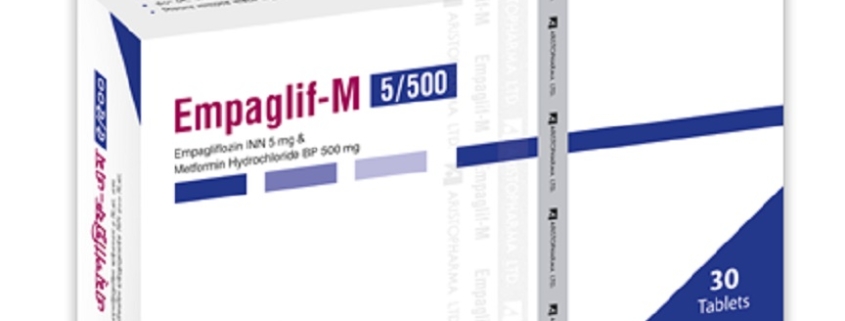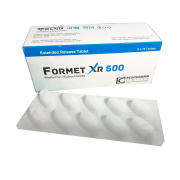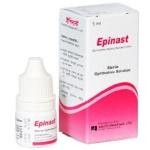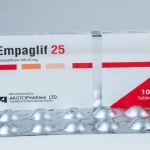Empaglif-M (Empagliflozin INN & Metformin Hydrochloride BP)
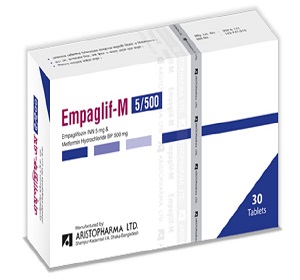
Empagliflozin INN & Metformin Hydrochloride BP
Empaglif-M combines 2 anti-hyperglycemic agents with complementary mechanisms of action to improve glycemic control in patients with type 2 diabetes: Empagliflozin, a sodium-glucose co-transporter 2 (SGLT2) inhibitor, and metformin, a member of the biguanide class.
Description
Empagliflozin: Sodium-glucose co-transporter 2 (SGLT2) is the predominant transporter responsible for reabsorption of glucose from the glomerular filtrate back into the circulation. Empagliflozin is an inhibitor of SGLT2. By inhibiting SGLT2, Empagliflozin reduces renal reabsorption of filtered glucose and lowers the renal threshold for
glucose, and thereby increases urinary glucose excretion.
Metformin: Metformin may exert its glucose-lowering effect via four mechanisms: By reduction of hepatic glucose production through inhibition of gluconeogenesis and glycogenolysis; In muscle, by modestly increasing insulin sensitivity, improving peripheral glucose uptake and utilization; By delaying intestinal glucose absorption; Stimulate
intracellular glycogen synthesis by acting on glycogen synthase and increase the transport capacity of glucose transporters (GLUT-1 & GLUT-4).
Presentation
Empaglif-M 5/500 Tablet: Each film-coated tablet contains Empagliflozin INN 5 mg & Metformin Hydrochloride BP 500 mg.
Empaglif-M 12.5/500 Tablet: Each film-coated tablet contains Empagliflozin INN 12.5 mg & Metformin Hydrochloride BP 500 mg.
Empaglif-M 10/1000 XR Tablet: Each film-coated tablet contains Empagliflozin INN 10 mg & Metformin Hydrochloride BP 1000 mg extended release.
Empaglif-M 25/1000 XR Tablet: Each film-coated tablet contains Empagliflozin INN 25 mg & Metformin Hydrochloride BP 1000 mg extended release.
Indications
Empaglif-M is a combination of Empagliflozin and Metformin Hydrochloride indicated as an adjunct to diet and exercise to improve glycemic control in adults with type 2 diabetes mellitus when treatment with both Empagliflozin and Metformin hydrochloride is appropriate.
Dosage & Administration
The recommended dose of Empaglif-M tablet is twice daily with a meal and Empaglif-M XR is single tablet once dailly with a meal in the morning; with gradual dose escalation to reduce the gastrointestinal side effects due to Metformin. Adjust dosing based on effectiveness and tolerability while not exceeding the maximum recommended daily dose of Metformin 2000 mg and Empagliflozin 25 mg.
Patients already treated with Metformin: If patient is taking Metformin 500 mg twice daily or maximum recommended daily dose of 2000 mg, then give him Empaglif-M 5/500 mg twice daily; otherwise Empaglif-M 10/1000 mg XR once daily. Patients already treated with Empagliflozin: If patient is taking Empagliflozin 10 mg once daily, then give him
Empaglif-M 5/500 mg twice daily or Empaglif-M 10/1000 mg XR once daily and If patient is taking Empagliflozin 25 mg once daily, then give him Empaglif-M 12.5/500 mg twice daily or Empaglif-M 25/1000 mg XR once daily.
Patients already treated with Empagliflozin and Metformin individual components: May be switched to Empaglif-M or Empaglif-M XR containing the same doses of each component. Do not initiate or continue in patients with serum creatinine levels greater than or equal to 1.5 mg/dL for males or 1.4 mg/dL for females. Do not initiate or continue Empaglif-M if eGFR is persistently less than 45 mL/min/1.73 m2.
In patients eligible for Empaglif-M based on creatinine cutoff criteria, no dose adjustment is needed if eGFR is greater than or equal to 45 mL/min/1.73 m2.
Contrainidications
Empagliflozin & Metformin combination is contraindicated in patients with: Renal impairment (e.g.: serum creatinine levels greater than or equal to 1.5 mg/dL for males or 1.4 mg/dL for females, or eGFR is less than 45 mL/min/1.73 m2), which may also result from conditions such as cardiovascular collapse (shock), acute myocardial infarction, and septicemia; end stage renal disease (ESRD) or patients on dialysis. Acute or chronic metabolic acidosis, including diabetic ketoacidosis. Diabetic ketoacidosis should be treated with insulin. History of serious hypersensitivity reaction to Empagliflozin or Metformin hydrochloride.
Warning & Precautions
Lactic acidosis: Empagliflozin & Metformin combination is not recommended due to metformin associated lactic acidosis; Hypotension: efore initiating Empagliflozin & Metformin combination assess and correct volume status in patients with renal impairment, the elderly, in patients with low systolic blood pressure, and in patients on diuretics; Impairment in renal function: Monitor renal function during therapy; Hypoglycemia: Consider lowering the dose of insulin secretagogues or insulin to reduce the risk of hypoglycemia when initiating mpagliflozin & Metformin combination; Genital mycotic infections: Monitor and treat as appropriate;
Urinary tract infections: Monitor and treat as appropriate; Vitamin B12 deficiency: Metformin may lower vitamin B12 levels. Monitor hematologic parameters annually;
Increased LDL-C: Monitor and treat as appropriate; Macrovascular outcomes: There have been no clinical studies establishing conclusive evidence of macrovascular risk reduction with Empagliflozin & Metformin combination; Urosepsis and Pyelonephritis: Evaluate patients for signs and symptoms of urinary tract infections and treat promptly, if indicated; Fournier’s gangrene (rare infection): Healthcare professionals should assess patients for Fournier’s gangrene if they present with the symptoms (tenderness, redness, or swelling of the genitals or the area from the genitals back to the rectum and have a fever above 100.4 F or a general feeling of being unwell). If suspected, start treatment mmediately with broad-spectrum antibiotics and surgical debridement if necessary.
Side effects
Most common adverse reactions associated with Empagliflozin (5% or greater incidence) are urinary tract infection and female genital mycotic infections and with Metformin (>5%) are diarrhea, nausea/vomiting, flatulence, abdominal discomfort, indigestion, asthenia, and headache.
Drug interaction
Drug Interactions with Empagliflozin Diuretics: Co-administration of Empagliflozin with diuretics resulted in increased urine volume and frequency of voids, which might enhance the potential for volume depletion; Insulin or Insulin Secretagogues: Coadministration of Empagliflozin with insulin or insulin secretagogues increases the risk for hypoglycemia.
Drug Interactions with Metformin Hydrochloride Cationic Drugs: Cationic drugs (e.g.: amiloride, digoxin, morphine, procainamide, quinidine, quinine, ranitidine, triamterene, trimethoprim, or vancomycin) that are eliminated by renal tubular secretion theoretically have the potential for interaction with Metformin by competing for common renal tubular transport systems. Although such interactions remain theoretical (except for cimetidine), careful patient monitoring nd dose adjustment of Empagliflozin & Metformin combination and/or the interfering drug is recommended in patients who are taking cationic medications that are excreted via the proximal renal tubular secretory system; Carbonic Anhydrase Inhibitors: Topiramate or other carbonic anhydrase inhibitors (e.g.: zonisamide, acetazolamide or dichlorphenamide) frequently decrease serum bicarbonate and induce non-anion gap, hyperchloremic metabolic acidosis. Concomitant use of these drugs may induce metabolic acidosis. Use these drugs with caution in patients treated with Empagliflozin & Metformin combination, as the risk of lactic acidosis may increase;
Drugs Affecting Glycemic Control: Certain drugs tend to produce hyperglycemia and may lead to loss of glycemic control. These drugs include the thiazides and other diuretics, corticosteroids, phenothiazines, thyroid products, estrogens, oral contraceptives, phenytoin, nicotinic acid, sympathomimetics, calcium channel blocking drugs, and isoniazid. When such drugs are administered to a patient receiving Empagliflozin & Metformin combination, the patient should be closely observed to maintain adequate glycemic control.
Use in special groups
Pregnancy: No adequate and well-controlled studies in pregnant women. Use during pregnancy only if the potential benefit justifies the potential risk to the fetus;
Nursing mothers: Discontinue Empagliflozin & Metformin combination or discontinue nursing;
Geriatric patients: Higher incidence of adverse reactions related to volume depletion and reduced renal function;
Patients with renal impairment: Higher incidence of adverse reactions related to reduced renal function.
In the event of an overdose with Empagliflozin & Metformin combination, contact the Poison Control Center. Employ the usual supportive measures (e.g.: remove unabsorbed material from the gastrointestinal tract, employ clinical monitoring, and institute supportive treatment) as dictated by the patient’s clinical status. Removal of Empagliflozin by hemodialysis has not been studied. However, Metformin is dialyzable with a clearance of up to 170 mL/min under good hemodynamic conditions.
Hepatic Impairment: Avoid use in patients with hepatic impairment.
Packing
Empaglif-M 5/500 Tablet: Each box contains 30’s tablets in alu-alu blister pack.
Empaglif-M 12.5/500 Tablet: Each box contains 30’s tablets in alu-alu blister pack.
Empaglif-M 10/1000 XR Tablet: Each box contains 12’s tablets in alu-alu blister pack.
Empaglif-M 25/1000 XR Tablet: Each box contains 12’s tablets in alu-alu blister pack.

